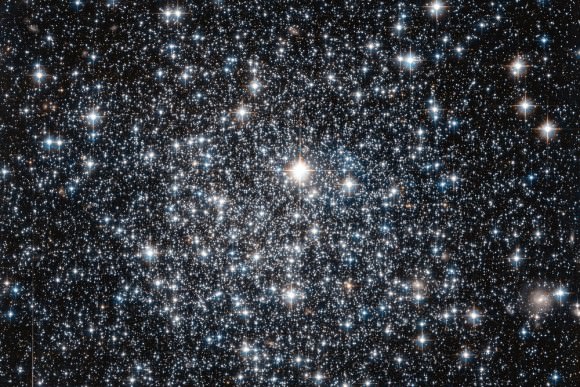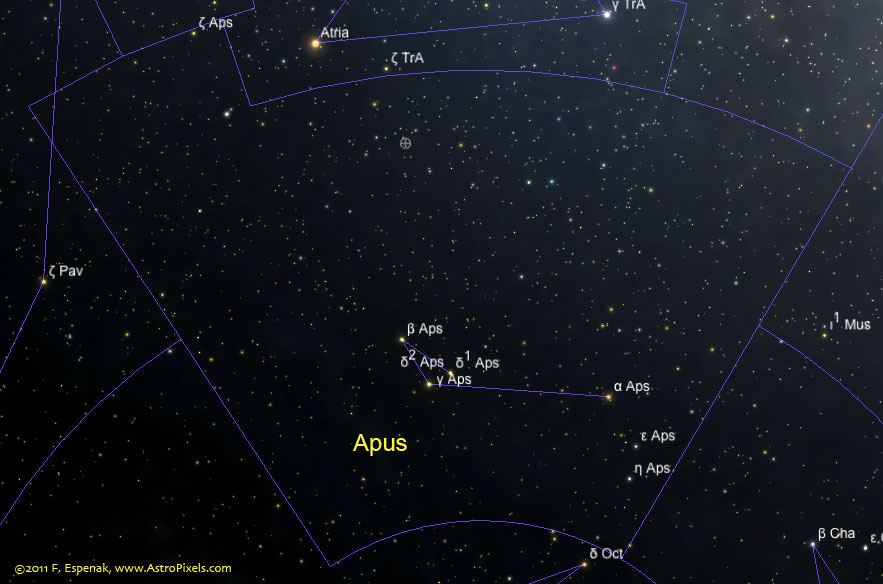Welcome back to Constellation Friday! Today, we will be dealing with the beautiful bird-of-paradise itself, the Apus constellation!
The Southern Hemisphere is replete with beautiful stars and constellations, enough to keep a stargazing enthusiast busy for a lifetime. For countless centuries, the indigenous peoples of South America, South Africa, Australia and the South Pacific have looked up at these stars and drawn inspiration. However, to European astronomers, they remained uncharted and unknown until the 16th century.
It was during this time that Flemish astronomer Petrus Plancius designated twelve constellations, using asterisms found in the southern skies. One such constellation was Apus, a faint constellation in the southern sky that is named for the bird-of-paradise – a beautiful bird that is indigenous to the South Pacific. Today, it is one of the 88 constellations defined by the International Astronomic Union (IAU).
Name and Meaning:
The name Apus is derived from Greek word apous, which literally means “no feet”. The name applies to a species of bird that is indigenous to Indonesia, Papua New Guinea, and Eastern Australia (which was believed at one time to have no feet). Its original name on Plancius’ charts was “Apis Indica” – the Latin term for “Indian Bee” (presumably an error for “avis”, which means bird).
Because of this error, the bordering constellation of Musca was later separated and renamed. The neighboring constellations to Apus are Ara, Chamaeleon, Circinus, Musca, Octans, Pavo, and Triangulum Australe.

History of Observation:
This faint southern constellation of Apus was one of the original twelve created by Plancius, based on observations provided by Pieter Dirkszoon Keyser and Frederick de Houtman – two Dutch explorers/navigators who mapped the southern sky around Australia between 1595 and 1597.
It was included on a celestial globe published in 1597 or 1598 in Amsterdam by Plancius and his associate, Flemish cartographer and engraver Jodocus Hondius. After it’s introduction on Plancius’ globe, it also appeared in Uranometria, a star atlas published by Johann Bayer – a German celestial catrographer – in 1603.
Here, it appeared under the name “Apis Indica”. It also grouped with the other members of the “Johann Bayer family” of constellations, all of which appeared in Uranometria. These include Chamaeleon, Dorado, Grus, Hydrus, Indus, Musca, Pavo, Phoenix, Tucana, and Volans. The constellation also appears as part of the Chinese constellations, where it is known as the “Little Wonder Bird”.
In the 17th century, Ming Dynasty astronomer Xu Guangqi adapted the European southern hemisphere constellations when producing The Southern Asterisms. Combining Apus with some of the stars in Octans, he designated the stars in this area of the night sky into the constellation known as Yìquè (“Exotic Bird”). In 1922, Apus was included by the International Astronomical Union in the list of 88 constellations.

Notable Features:
Within the Apus constellation, there are 39 stars that are brighter than or equal to apparent magnitude 6.5. The most notable of these is Alpha Apodis. an orange giant star with a magnitude of 3.8, located roughly 411 light years away from Earth. Beta Apodis is also an orange giant, with a magnitude of 4.2. and located 158 light years from Earth. And Gamma Apodis , another orange giant, has a magnitude of 3.9 and is located 160 light years away.
Delta Apodis is a binary star system consisting of a red giant and an orange giant. Delta¹ has a magnitude of 4.7 and is located 765 light years away, while Delta² has a magnitude of 5.3 and is located 663 light years away. Then there is Theta Apodis, a variable red giant star with a maximum magnitude of 4.8 and a minimum of 6.1 that is located 328 light years away.
NO Apodis is a red giant that varies between magnitudes 5.71 and 5.95 and is located around 883 light-years away from Earth. This star shines with a luminosity that is approximately 2059 times greater than our Sun’s and has a surface temperature of 3568 K.
Apus is also home to a few Deep Sky Objects. These include the IC 4499 loose globular cluster (shown below), which is located in the medium-far galactic halo and has an apparent magnitude of 10.6. This object is rather unique in that its metallicity readings indicate that it is younger than most other globular clusters in the region.

Then there’s NGC 6101, a 14th mangitude globular cluster located seven degree north of Gamma Apodis. Last, there is the spiral galaxy IC 4633, which is very faint due to its location well within the Milky Way’s nebulous disc.
Finding Apus:
For binoculars, take a look at Alpha Apodis. This 3.8 magnitude star is located 411 light years away from Earth. Now move on to Delta. It is a wide double star which is two orange 5th-magnitude members separated by 103 arc seconds and an easy split. Or try observing Theta – its a variable star whose brightness ranges from magnitude 4.8 to 6.1 in a period of 109 days.
For telescopes, take a look at more difficult binary star Kappa-1 Apodis. The brightest component of this disparate pair has a magnitude of 5.4 and the companion is 12th magnitude, 27 arcseconds away. Need more? Then turn your gaze towards Kappa-2 only 0.63 degrees from Kappa-1. Kappa-1 Apodis is a binary star approximately 1020 light years from Earth. The primary component, Kappa-1 Apodis A, is a blue-white B-type subgiant with a mean apparent magnitude of +5.40. It is classified as a Gamma Cassiopeiae type variable star and its brightness varies from magnitude +5.43 to +5.61. The companion star, Kappa-1 Apodis B, is a 12th magnitude orange K-type subgiant. It is 27 arc seconds from the primary.
For larger telescopes, wander off and look at NGC 6101 located about seven degrees north of Gamma. Here we have a small, 14th magnitude globular cluster! If you’re really good you can try for spiral galaxy IC 4633. It’s so faint it doesn’t even have a magnitude listing!
We have written many interesting articles about the constellation here at Universe Today. Here is What Are The Constellations?, Triangulum Australe, What Is The Zodiac?, and Zodiac Signs And Their Dates.
Be sure to check out The Messier Catalog while you’re at it!
For more information, check out the IAUs list of Constellations. and the Students for the Exploration and Development of Space page on Apus and Constellation Families.

